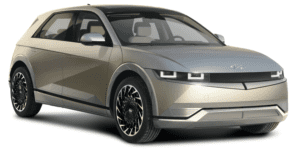 The Hyundai Ioniq 5 is a line of compact five-door liftback and five-door hatchback vehicles manufactured by Hyundai Motor Company. The Ioniq was first introduced in 2016 as a dedicated hybrid, plug-in hybrid, and electric vehicle platform.
The Hyundai Ioniq 5 is a line of compact five-door liftback and five-door hatchback vehicles manufactured by Hyundai Motor Company. The Ioniq was first introduced in 2016 as a dedicated hybrid, plug-in hybrid, and electric vehicle platform.
The Hyundai Ioniq 5 hybrid is powered by a 1.6-liter four-cylinder engine paired with an electric motor and a lithium-ion battery pack. It has a combined output of 139 horsepower and 195 lb-ft of torque and is equipped with a six-speed dual-clutch automatic transmission.
The Ioniq 5 plug-in hybrid has a larger battery pack that allows for electric-only driving for up to 29 miles before the gasoline engine kicks in. The Ioniq Electric, on the other hand, is a fully electric vehicle that is powered by a 38.3 kWh battery pack and an electric motor that produces 134 horsepower and 218 lb-ft of torque. It has an estimated range of up to 170 miles on a single charge.
The Ioniq’s 5 interior features a modern design with a range of technology features such as an infotainment system with a touchscreen display, Apple CarPlay and Android Auto compatibility, and a suite of advanced safety features such as automatic emergency braking, lane departure warning, and adaptive cruise control. You can add Hyundai Ioniq 5 accessories to enhance the interior.
Overall, the Hyundai Ioniq 5 is a popular and well-regarded alternative to other hybrid and electric vehicles on the market, offering a balance of efficiency, technology, and style.
The Hyundai Ioniq 5 Accessories
The Hyundai Ioniq 5 is a popular electric crossover SUV that offers a variety of Hyundai Ioniq 5 accessories to enhance its functionality and aesthetics. Some of the most popular accessories for the Ioniq 5 include:
-
Cargo Tray: This is a tray that fits perfectly in the cargo area of the Hyundai Ioniq 5, protecting the carpet from dirt and spills.
-
Floor Mats: There are several types of floor mats available for the Hyundai Ioniq 5, including rubber, carpet, and all-weather mats. They help protect the interior of the car from dirt, water, and other debris.
-
Roof Rack: A roof rack can be added to the Ioniq 5 to provide additional storage space for items like bicycles, skis, or luggage.
-
Cargo Net: This is a handy accessory that can be used to keep items in the cargo area secure while driving.
-
Sunshade: A sunshade can be used to protect the interior of the Hyundai Ioniq 5 from the sun’s harmful UV rays, while also keeping the cabin cooler.
-
Seat Covers: Seat covers can be added as a Hyundai Ioniq 5 accessory to protect the seats from spills and stains, as well as general wear and tear.
-
Wireless Phone Charger: This accessory can be added to the Ioniq 5 to allow for wireless charging of compatible smartphones.
-
Illuminated Door Sill Plates: These plates light up when the doors are opened, adding a touch of style to the interior of the car.
-
Hood Protector: A hood protector can be added to the Ioniq 5 to protect the front of the car from chips and scratches caused by road debris.
-
Mudguards: Mudguards can be added to the Ioniq 5 to protect the car’s paint from rocks, mud, and other debris kicked up by the tires.
The Hyundai Ioniq hybrid or electric vehicle Parts
The Hyundai Ioniq is a hybrid or electric vehicle, and as such, it has several unique parts that differ from traditional gasoline-powered cars. Some common parts for the Hyundai Ioniq include:
- Electric Motor: This is the primary source of propulsion for the electric version of the Ioniq. The motor converts electrical energy from the battery into rotational force that turns the wheels.
- Battery Pack: The Ioniq’s battery pack stores electrical energy that powers the electric motor. The battery pack is typically located under the rear seat or in the trunk of the car.
- Inverter: The inverter converts the DC electricity from the battery into AC electricity that is used to power the electric motor.
- Charging Port: The charging port is located on the outside of the car and is used to connect the car to an external power source for recharging the battery
- . Hybrid System: The hybrid version of the Ioniq has both an electric motor and a gasoline engine, along with a complex system of sensors and controllers that manage the two power sources.
- Brakes: The Ioniq’s brakes include both traditional hydraulic brakes and regenerative brakes that capture kinetic energy from the wheels and convert it into electrical energy that can be stored in the battery.
- Suspension: The Ioniq’s suspension includes MacPherson struts at the front and a multi-link suspension at the rear.
- Tires: The Ioniq uses low-rolling-resistance tires to maximize fuel efficiency and reduce noise.
- Interior Components: The Ioniq’s interior includes a variety of unique components, including an LCD instrument cluster, a digital display for the infotainment system, and a variety of controls for the car’s hybrid or electric systems.
- Body Parts: The Ioniq’s body is made from a variety of materials, including high-strength steel, aluminum, and composites, to maximize strength and reduce weight.
Are Hyundai parts expensive?
The cost of Hyundai parts can vary depending on the specific part and the location of the dealership or repair shop. In general, OEM (Original Equipment Manufacturer) parts from Hyundai tend to be more expensive than aftermarket parts, which are produced by third-party manufacturers.
However, it’s important to note that OEM parts are often of higher quality and come with a warranty, which can provide greater peace of mind for vehicle owners. Additionally, using OEM parts may be necessary to maintain the manufacturer’s warranty on a vehicle.
Overall, while Hyundai parts may be more expensive than aftermarket alternatives, the cost can vary widely depending on the specific part and where it is purchased from. It’s always a good idea to compare prices from multiple sources and consult with a trusted mechanic or dealership to determine the best option for your specific situation.
Homepage: EV Parts
